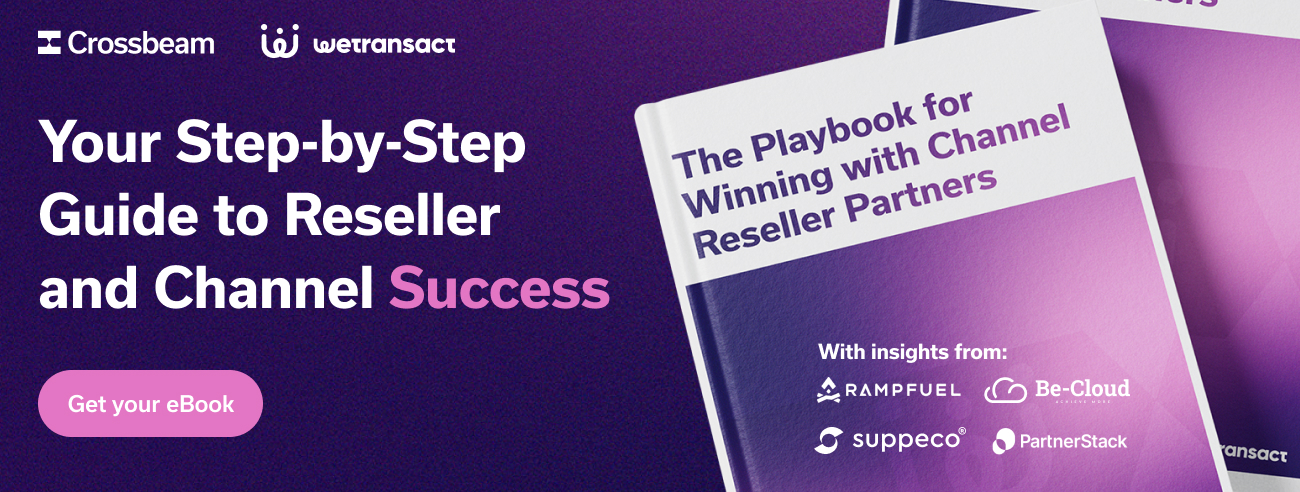Learn how to scale and optimize mature channel reseller programs into high-margin revenue engines. Discover advanced partner management strategies, tech stacks, cadences, and leadership tactics to drive partner-sourced growth.

If you’ve read The Playbook for Winning with Channel Reseller Partners or followed our channel management articles, you already know the fundamentals of a reseller program. But once the foundational pieces are in place, the true differentiator is how effectively you own, scale, and optimize that program.
For seasoned channel managers, this is where you shift from “running a program” to engineering a revenue engine.
Whether you’ve been promoted into a global role, inherited a portfolio of mature partnerships, or are spearheading a strategic market expansion, your remit demands precision, foresight, and the operational stamina to manage complexity at scale.
We recommend reading this if you:
- Manage an established partner portfolio and want to increase partner-sourced revenue.
- Decide it’s time to scale your channel motion.
- Are transitioning from a CAM (Channel Account Manager) to a regional/global Channel Director role.
- Are building out a specialized channel partner team under an existing program.
- Sit in the C-suite and want to optimize ROI from a multi-tier partner ecosystem.
Channel management teams and operational ownership
In advanced channel leadership, complexity isn’t a problem, it’s the environment. Multiple active partner tiers, deal registrations, co-marketing campaigns, MDF (Market Development Funds) allocations, and overlapping regional plays mean that without a strong operational owner, even the most promising partnerships can stall.
In earlier stages, this “owner” might have been the founder or a hybrid BD leader. At scale, your role as Channel Partner Manager (or Channel Account Director, depending on org size) is to orchestrate the entire channel partner lifecycle.
Here are the core Channel Partner Manager activities (tactical and operational):
- Partner onboarding and ramp: Guiding new partners through your enablement framework, delivering product training, and ensuring they can sell and support independently.
- Partner recruitment through marketplaces: Use marketplace ecosystems (for example: Microsoft Commercial Marketplace) to identify and recruit partners with proven sales in your category.
- Incentive alignment: Leverage marketplace incentive programs (for example: Microsoft’s co-sell incentives, AWS MAP funding) to motivate partners.
- Pipeline health monitoring: Tracking deal registrations, partner-sourced opportunities, and forecasting revenue contribution by partner.
- Co-selling support: Coordinating with internal sales, solutions engineers, and customer success to close joint deals faster.
- Marketing execution: Activating co-marketing campaigns, tracking MDF spend, and optimizing for lead conversion.
- Performance reporting: Maintaining dashboards that show partner performance against KPIs, such as deal velocity, win rate, and average deal size.
- Compliance oversight: Ensuring partners follow territory agreements, deal reg rules, and brand guidelines.
And here are Senior and Strategic Channel Leadership tasks:
- Ecosystem mapping: Identifying and developing new strategic alliances that expand market coverage or create category leadership.
- Partner tier optimization: Designing or refining your tier structure to drive partner behavior toward high-value activities.
- Joint GTM strategy: Co-developing multi-quarter plans with top-tier partners, including new product launches, geographic expansions, and vertical-specific plays.
- Executive relationship building: Maintaining C-level alignment between your company and the partner’s leadership to ensure strategic buy-in and faster conflict resolution.
- Revenue portfolio management: Prioritizing resources and budget toward the highest-growth, highest-margin partners while strategically sunsetting underperformers.
- Global program governance: Standardizing processes across regions, ensuring scalability without sacrificing partner experience.
- Competitive defense planning: Coordinating joint plays with partners to block competitors from gaining market share in key accounts or territories.
- Influence on product roadmap: Feeding back market intelligence from partners to shape product strategy and secure partner-first differentiators.
So, what is the ideal ratio for your team? It depends on the size of your company and your team, but if you’re a midsize or enterprise company: one Channel Partner Manager per 5–10 active partners, revenue-producing partners, adjusting based on ARR per partner, sales cycle complexity, and co-selling intensity.
As you grow partner-sourced revenue, your org structure might evolve to include:
- Senior Channel Partner Managers (enterprise-tier partners)
- Channel Partnerships Manager (program-level initiatives)
- Channel Solutions Engineer (technical enablement)
- Channel Operations Analyst (reporting, data integrity)
- Channel Sales Manager (quota-carrying partner deals)
Tools for advanced channel operations
Your channel is only as strong as the operational infrastructure supporting it. For experienced Channel Partner Managers, this means integrating tools that not only handle partner data intelligence, pipeline attribution, and multi-market compliance—but also create a frictionless environment for collaboration and growth.
Below is a curated tool stack every Channel Partner Manager should have to run and scale their program effectively:
Comms and collaboration
- Slack or Microsoft Teams for real-time communication with tier-1 partners and internal partner teams.
- Zoom, Google Meet, or Gong for structured check-ins, training, and Quarterly Business Reviews (QBRs).
- SharePoint, Google Drive, or Notion for hosting sales enablement assets, price lists, and marketing collateral.
- Asana, Trello, or Monday.com for coordinating cross-team GTM plays, campaign launches, and partner enablement schedules.
CRM and partner data management
- Salesforce, HubSpot, or Microsoft Dynamics for having custom partner fields for pipeline attribution, deal reg, and performance tracking.
- Custom objects and workflows for automating partner follow-ups, pipeline stage changes, and deal approval processes.
Partner Relationship Management (PRM) and MDF management
- PartnerStack or 360Insights for automating onboarding, deal registration, incentive payouts, and partner communications at scale.
- MDF tracking tools either within PRM platforms or standalone solutions for managing fund requests, approvals, and ROI measurement.
Ecosystem Intelligence
- Crossbeam for building targeted lead lists with automated channel mapping, prioritizing the right leads with built-in propensity scores, distributing leads with confidence and eliminating channel conflict, running the co-sell plays that convert, and streamlining your workflow with CRM and PRM integrations.
Marketing management
- HubSpot Marketing Hub, Marketo, or Campaign Monitor for executing co-marketing campaigns and track engagement.
Marketplace management
- WeTransact for simplifying marketplace selling for partners by handling tax, compliance, and currency complexities.
- Marketplace Native Analytics like AWS Marketplace Insights, Microsoft Partner Center analytics, and Google Cloud Console for tracking traffic, conversions, and deal flow.
Community and ecosystem engagement
- Partnership Leaders for networking, best practice sharing, and peer learning.
- WeTransact’s Discourse community for partner training and certification programs.
An advanced channel tech stack should not just “support” the program, it should accelerate decision-making, eliminate friction, and make partner collaboration effortless. When built right, these tools become the silent drivers of partner-sourced revenue growth.
Advanced cadence management
Juan Jose Castiblanques, CPO and Co-Founder at WeTransact, sums up the partner manager role in two words: proactivity and coordination. In a mature channel environment, cadence discipline is non-negotiable.
External cadences: Partner-facing:
- Weekly/biweekly tactical syncs: Targeted agenda: deal blockers, product updates, competitive intel. Consider alternating between live calls and concise, data-rich summaries to respect partner bandwidth.
- Monthly pipeline review: Go beyond open leads and bring conversion ratios, win/loss analysis, and deal velocity data to the table.
- Quarterly Business Review (QBR): Executive-level alignment on revenue targets, co-marketing ROI, and market expansion priorities. Support with a “partner scorecard” (KPIs + qualitative health metrics).
- Annual partnership planning: Strategic renewal discussions expanding into new geos, co-investment in enablement, new product launches, and contract optimization.
Internal cadences: Org-facing:
- Weekly internal partner pipeline meeting: Ensure every partner-sourced deal is properly tracked, credited, and followed up.
- Monthly ops review: Audit commission payouts, MDF balances, and SLA adherence for partner deliverables.
- SOP and playbook governance: Standardize playbooks for onboarding, QBRs, issue escalation, and inactive partner re-engagement.
One critical playbook? Partner Issue Resolution: a time-bound, documented escalation path to address pricing disputes, competitive conflicts, or operational breakdowns before they damage trust.
A final word for channel leaders
Your role as a channel leader is to own the revenue outcomes, not just the relationships. With deliberate cadences, a precision tech stack, and a portfolio management mindset, you can turn a good partner program into a scalable, high-margin growth engine.
Remember: in channel, you’re never working alone. You have your team, your partners, and your playbooks.
Want to build a reseller motion?
Download our free ebook, The Playbook for Winning with Channel Reseller Partners, for advanced guidance, enterprise-grade frameworks, and real-world channel case studies to scale your partner-sourced revenue.










































































































